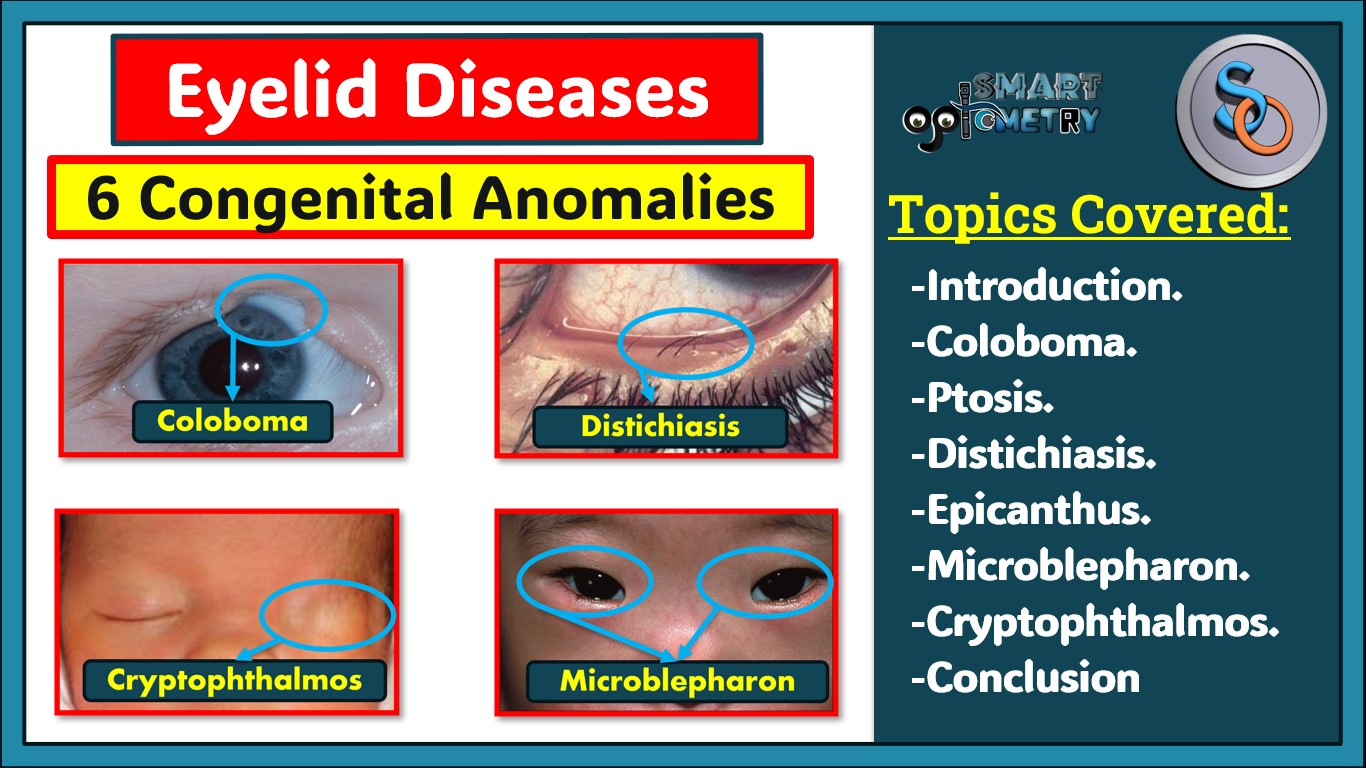Congenital anomalies of eyelid:
- 6 Congenital anomalies of eyelid are:
- 1. Congenital ptosis.
- 2. Congenital Coloboma.
- 3. Epicanthus.
- 4. Distichiasis.
- 5. Cryptophthalmos.
- 6. Microblepharon.
- These conditions affect the normal development of the eyelids and can impact vision, comfort, and appearance. Let’s dive into each of these unique conditions.”
1. Congenital ptosis:

- Normally, upper lid covers about upper one-sixth of the cornea that is about 2 milometers.
- Therefore, Ptosis is abnormal drooping of the upper eyelid that covers more than 2 milometers of superior cornea.
- And Congenital ptosis is a condition where the upper eyelid droops due to maldevelopment of the levator palpebrae superioris muscle or LPS muscle.
- It may occur in different forms like:

a. Simple congenital ptosis:
- Other than weakness of LPS muscles, no anomalies are present.
b. Congenital ptosis with superior rectus muscle weakness:
- It leads to both drooping upper eyelid and limited upward eye movement.
c. Ptosis as part of Blepharophimosis Syndrome:
- where patients also show signs of Telecanthus and epicanthus inversus.
d. Marcus Gunn jaw-winking ptosis:
- where the eyelid retracts when the jaw moves.
.
.
2. Congenital Coloboma

- Congenital Coloboma is a rare condition that creates a full-thickness triangular gap in the tissues of the eyelid, often near the nasal side and affecting the upper eyelid more frequently.
- The primary treatment for this condition is plastic surgery to repair the defect and restore the eyelid’s function and appearance.
3. Epicanthus

- Epicanthus is a common congenital anomaly, particularly among the Mongolian races.
- It’s characterized by a semicircular fold of skin that covers the inner corner of the eye, or the medial canthus.
- This fold may disappear as the nose develops, but in more severe cases, plastic surgery can be performed to correct the condition.
.
.
4. Distichiasis

- Distichiasis is a rare condition where an extra row of eyelashes grows where the meibomian glands should be.
- These extra lashes often point inward, rubbing against the cornea and causing irritation.
- Treatment involves epilation, electroepilation or cryoepilation to remove these lashes and prevent further discomfort.
5. Cryptophthalmos

- Cryptophthalmos is an extremely rare anomaly where the eyelids fail to develop, and the skin extends seamlessly from the eyebrow to the cheek, hiding the eyeball beneath.
- In these cases, surgery may be considered to expose the eyeball, but treatment is complex and depends on the severity of the condition.
.
.
6. Microblepharon

- Microblepharon is a condition where the eyelids are abnormally small.
- It’s usually associated with smaller-than-normal eyes, known as microphthalmos, or even absent eyes, called anophthalmos.
- In some cases, the eyelids are so small or underdeveloped that the condition is called ablepharon.
- Check Our Courses: Ophthalmic Instrumentation, Clinical Refraction, Contact Lens, Binocular Vision, Dispensing Optics, MCQs in Optometry
- Download our App “Optometry Notes & MCQs” from Google Play Store.





4 Comments
Stay with smart optometry and study Optometry Smartly.
Useful piece
Stay with smart optometry and study optometry smartly
It is remarkable, this rather valuable message